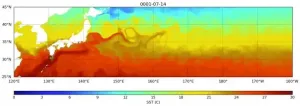High-resolution ocean model provides insight into sea turtles' lost years
Model shows where hatchlings likely travel in the open ocean
2021-03-04
(Press-News.org) An exquisitely detailed global ocean model simulation from the National Center for Atmospheric Research (NCAR) has given scientists rare insight into where baby sea turtles may go in their "lost years" after they scramble off the sandy beaches where they are born and swim into the open ocean.
This look at a critically important period in the life cycle of endangered loggerhead turtles could help inform more comprehensive conservation efforts that encompass regions of the open ocean where young turtles grow, and not just the nesting beaches. It also pinpoints regions of the ocean that are important to study to better understand how to protect sea turtles.
"To understand where sea turtle hatchlings are being swept to when they enter the open ocean -- and how favorable that habitat is to turtle survival -- we need to simulate smaller scale ocean features, the jets and eddies that transport these younglings," said Cheryl Harrison, a researcher at the University of Texas Rio Grande Valley, who led the study. "The models typically used to simulate global ocean movement are too coarse for us to resolve these important features. The really exciting thing about this study is we were able to use a high-resolution, eddy-resolving model to track where turtles are traveling."
The ocean simulation used for the new study, published in the journal Royal Society Interface, was run using the NCAR-based Community Earth System Model at a resolution that is an order of magnitude higher than standard global modeling runs. The model also contains complex biogeochemistry, which allowed the researchers to estimate food availability along the turtles' path.
The research was funded by the National Science Foundation, which is NCAR's sponsor, NASA, and the U.S. Department of Energy. Harrison began work on the study as a postdoctoral researcher at NCAR, working with oceanographer Matthew Long, who co-authored the study. Harrison is now an assistant professor at the University of Texas Rio Grande Valley.
Finding the lost years
Loggerhead turtles nest on specific beaches scattered around the globe, often where strong currents come close to land. After hatching, the baby turtles head for the ocean, where they spend the next several years as they mature. Once they reach sexual maturity decades later, the turtles eventually return to the beach where they were born to mate and lay their own eggs before the cycle begins again.
For the new study, Harrison and her colleagues studied how hatchlings are likely to disperse during the first year of their lives from nesting sites on the coasts of Japan, Florida, Cape Verde, Oman, west Australia, east Australia, Brazil, and South Africa. Because the baby sea turtles must stay near the surface of the ocean to breathe -- and because they are not yet able to swim for significant periods -- the researchers were able to emulate their possible journeys using a method known as particle tracking, which follows how particles "released" into the model move with simulated water trajectories over time.
The results show that at many of the nesting sites, strong nearby currents -- including the Kuroshio, Gulf Stream, Brazil, and Agulhas currents -- sweep the turtles poleward to a region of ocean where two circular ocean currents (known as gyres) come together. This boundary between the subpolar and subtropical gyres is warm enough for the hatchlings to survive and also rich with zooplankton and other food that turtles depend on to survive.
The study results help demarcate the regions where turtles from each beach are going in their "lost years" when ecologists cannot easily keep tabs on them. For example, turtles born in southeastern Florida travel with the Gulf Stream all the way to the Azores, a productive and warm ocean habitat perfect for nurturing them.
At other nesting sites, such as the one on the coast of Oman, the hatchlings do not hitch a ride on a strong current to far-off ocean habitats. Instead, they use a local current that disperses them relatively nearby because the area waters are already suitable for the young turtles. This understanding of where the turtles go allows scientists to better understand what threats the turtles may be facing.
"Sea turtle hatchlings are very difficult to track and observe as they have high mortality rates and grow out of tags quickly," Harrison said. "Modelling studies help us close this observational gap and predict where they are going in the 'lost years.' Identifying ocean habitat helps us understand what factors are important for their survival in this life stage."
INFORMATION:
About the article
Title: Identifying global favourable habitat for early juvenile loggerhead sea turtles
Authors: Cheryl S. Harrison, Jessica Y. Luo, Nathan Putman, Qingfeng Li, Pooja Sheevam, Kristen Krumhardt, Jessica Stevens, Matthew C. Long
Journal: Journal of the Royal Society Interface
This material is based upon work supported by the National Center for Atmospheric Research, a major facility sponsored by the National Science Foundation and managed by the University Corporation for Atmospheric Research. Any opinions, findings and conclusions or recommendations expressed in this material do not necessarily reflect the views of the National Science Foundation.
[Attachments] See images for this press release:

ELSE PRESS RELEASES FROM THIS DATE:
2021-03-04
DALLAS, March 4, 2021 -- The rate of cardiovascular risk factors among Hispanic/Latino people living in the U.S. is very high, and while they are often aware of their health conditions, less than half of the Hispanic/Latino adults with history of stroke or transient ischemic attack (TIA) had healthy blood pressure and cholesterol, and about half had healthy blood sugar levels, according to new research published today in Stroke, a journal of the American Stroke Association, a division of the American Heart Association.
According to the American Heart Association, from 2015 to 2018, 52.3% of Hispanic men and 42.7% of Hispanic women aged 20 years and older had cardiovascular disease (CVD).
"It's a wake-up call for ...
2021-03-04
Bottom Line: Cancer survivors had a greater risk of reduced ambulatory function, which was associated with an increased risk of death.
Journal in Which the Study was Published: Cancer Epidemiology, Biomarkers & Prevention, a journal of the American Association for Cancer Research
Author: Elizabeth Salerno, PhD, MPH, assistant professor of surgery at Washington University School of Medicine in St. Louis, who conducted the research at the National Cancer Institute
Background: The diagnosis and treatment of cancer has been shown to be associated with poor functional health for common cancer types, such as those of the breast and prostate, but less is known about the association for other cancers, explained Salerno. "Given that cancer survivors are living longer than ever, ...
2021-03-04
A new study led by Washington University School of Medicine in St. Louis and the National Cancer Institute (NCI) has identified an association between slow walking pace and an increased risk of death among cancer survivors.
While the study does not establish that slow walking is a cause of death, the association persisted across at least nine tumor types. Investigators now call for more research into these relationships and whether targeted interventions such as physical activity programs could help cancer survivors improve their ability to walk and increase survival after cancer diagnosis and treatment.
The study, a collaboration between Washington University, the NCI of the ...
2021-03-04
The loss of seagrass in the waters around the UK is much higher than previously estimated. A new study published in Frontiers in Plant Science concludes that, with high certainty, at least 44% of the UK's seagrasses have been lost since 1936, of which 39% has been since the 1980s. This study is one of the first of its kind to bring together seagrass data from diverse sources and give a systematic estimate of the current and historic extent of seagrass, as well as seagrass loss in the UK.
The study was a collaboration between researchers at University College London, Kings College London, and Swansea University.
Seagrasses as climate change superheroes
Nature-based solutions are essential to mitigate the effects of the climate crisis, and seagrasses are highly ...
2021-03-04
(Boston)--Children in Zambia under age 5 die at a rate that is between nearly six to more than 10 times higher than those in the U.S; it is estimated at 40-75 per 1000, compared to 6.98 per 1000. Identifying why these children are dying is the mission of Rotem Lapidot, MD, assistant professor of pediatrics at Boston University School of Medicine (BUSM).
"Significantly, over 80 percent of all community infant deaths involved some form of delay. While it is impossible to know what would have occurred in the absence of such delays, the majority of infant deaths in Lusaka, the capital of Zambia, are from causes for which effective treatments currently exist," explained Lapidot, the corresponding author on the study ...
2021-03-04
The far-reaching mobility restrictions at the beginning of the Corona pandemic in March 2020 created a unique situation for atmospheric sciences: "During the 2020 lockdown, we were able to directly investigate the actual effects of drastic traffic restrictions on the distribution of air pollutants and on the emission of climate gases," says Innsbruck atmospheric scientist Thomas Karl. With his team, he has now published a detailed analysis of air quality during the first lockdown in the city of Innsbruck, Austria, in the journal Atmospheric Chemistry and Physics. "We find significantly greater decreases of air pollutants than of carbon dioxide, for example," the researcher says, summarizing the results. In the past year, some studies showed contradicting ...
2021-03-04
Tiny photonic devices could be used to find new exoplanets, monitor our health, and make the internet more energy efficient. Researchers from Chalmers University of Technology, Sweden, now present a game changing microcomb that could bring advanced applications closer to reality.
A microcomb is a photonic device capable of generating a myriad of optical frequencies - colours - on a tiny cavity known as microresonator. These colours are uniformly distributed so the microcomb behaves like a 'ruler made of light'. The device can be used to measure or generate frequencies with extreme precision.
In a recent article in the journal ...
2021-03-04
Using data collected in a NASA Langley Mach 6 wind tunnel, researchers at the University of Illinois Urbana-Champaign replicated the hypersonic flow conditions of a compression ramp flow by means of Direct Numerical Simulation. The simulation yielded an abundance of additional data, which can be used to better understand the phenomena that occur surrounding vehicles traveling at hypersonic speeds.
"Data from experiments are somewhat limited--for example taken from pressure probes at a few locations on a test object. When we run a numerical simulation, we acquire information - such as pressure, temperature, ...
2021-03-04
A rapid microbiological point-of-care test to diagnose respiratory infections has proved popular with GPs and could reduce antibiotic prescribing in primary care, according to a National Institute for Health Research funded study by researchers at the Centre for Academic Primary Care, University of Bristol.
There are high rates of antibiotic prescribing in primary care and the UK government has called for the introduction of rapid diagnostics to curb overuse.
The RAPID-TEST study, published in the journal Family Practice today [4 March] evaluated ...
2021-03-04
Scientists at the Francis Crick Institute and UCL have identified the trigger of a key cellular change in amyotrophic lateral sclerosis (ALS), a type of motor neurone disease. The findings could help develop new treatments for many neurological diseases with the same change, including Parkinson's and Alzheimer's.
When the nervous system is injured, diseased or infected, star-shaped cells, called astrocytes, undergo 'reactive' changes in their behaviour. Whilst some of these reactive astrocytes become protective, others become harmful and damage surrounding motor neurons.
Reactive astrocytes are observed in various neurodegenerative diseases including ALS, but there is a lack of understanding about what causes astrocytes to ...
LAST 30 PRESS RELEASES:
[Press-News.org] High-resolution ocean model provides insight into sea turtles' lost years
Model shows where hatchlings likely travel in the open ocean



